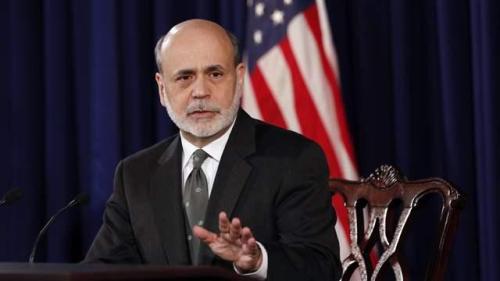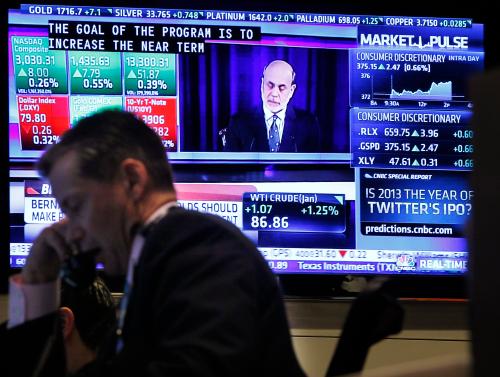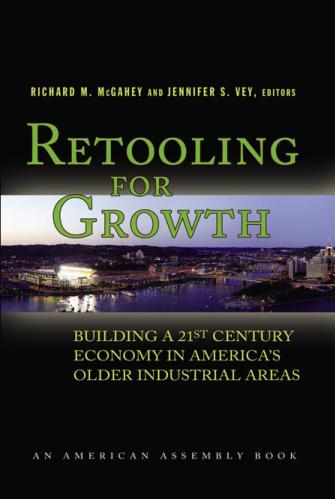On December 12, 2013, Alice M. Rivlin testified before the U.S. House of Representatives Committee on Financial Services. Her written testimony follows. A full PDF of the “Rethinking the Federal Reserve’s many mandates on its 100-year anniversary” hearing can be found here.
Thank you for inviting me to testify on this very important question: what economic goals should Americans expect their central bank to aim for? I do not believe there is a simple answer to this question. We can’t tell the Federal Reserve; just control inflation or just maximize employment or just keep the financial system stable. Americans, quite rightly, have multiple objectives for the performance of their economy, including high employment, low inflation, and financial stability. The job of the Federal Reserve and other economic policy-makers is to balance those multiple objectives as effectively as they can. This is not an easy task. It requires analysis and judgment in the face of necessarily uncertain forecasts. But focusing on a single objective would lead to less satisfactory economic performance. I will expand on this basic thought briefly this afternoon.
Multiple economic objectives. First, we want the economy to grow fast enough to create jobs—preferably good jobs—for almost everyone who wants to work. Even if we start with high rates of employment, the economy must grow fast enough to create sufficient additional jobs to keep up with growth in the labor force and worker productivity. If the economy grows too slowly, unemployment will rise and discouraged workers will drop out of the labor force, but if it grows too fast, shortages will develop and prices will likely begin to rise.
Second, we want low inflation or a fairly stable price level. We should not aim for zero inflation, because that makes it harder for resources to move out of falling-demand sectors and risks tipping the economy into deflation. But persistent inflation above moderate rates (say, two or three percent) can disrupt business and household planning, discourage long-run investment, and generate expectations that could cause inflation to accelerate to truly disruptive rates.
Third, we want to avoid financial crises with the potential endanger to economic activity in a major way. The recent financial crisis of 2008 amply demonstrates the catastrophic cost of a national housing price bubble and an over-leveraged, out-of-control financial sector.
In general, the goals reinforce each other. Low inflation and financial stability are conducive to long-run investment and stronger growth and employment. But sometimes balancing is necessary. For example, reducing the risk of inflation or financial instability may require slowing growth and job creation.
Navigating uncertainty. The economy is an extremely complex system with myriad inter-related moving parts, which is impossible to predict accurately. Statistical models can be extremely helpful in organizing past data, but they can be misleading when crucial relationships are changing. For example, when lending standards deteriorated dramatically in the last decade, models based on past mortgage payment rates of Americans proved utterly wrong. Policy makers have to use judgment as well as models, and judgments will differ.
The Fed’s past track record is clearly mixed. Skillful monetary policy deserves some of the credit for the fact that inflation has been quiescent for more than three decades, although partial credit must also go to fiscal policy (for example, the restrictive fiscal policy of much of the 1990s) and an increasingly flexible, competitive economy, nationally and internationally. The Fed certainly bears some of the blame—along with many other culprits, public and private—for its failure to spot the dangers of the deteriorating lending standards that contributed to the housing bubble and inaction in the face of the over-leveraged pyramid of housing-related derivatives, whose crash brought the world economy to its knees. Arguably, the Fed’s low interest rates in 2003-4 also contributed to the bubble and the over-leveraging, but short-term interest rates are not a sharp tool for dealing with asset bubbles. Lax regulation by the Fed and other regulators bears a far higher share of the blame than monetary policy.
Once the unnecessary crisis happened, the Fed moved aggressively and imaginatively in cooperation with the Treasury to mitigate the economic damage and stabilize the financial sector using all the tools it could find. The lessons learned in that desperate period of damage control, helped this Committee and its Senate counterpart craft the Dodd-Frank legislation aimed at avoiding repetition of the debacle of 2008. The Fed and other regulators now have new tools, which, if used courageously and intelligently, can reduce the chances of a similar catastrophe.
Multiple Mandates in the Current Economic Situation. The Fed’s policy of aggressive, continuous monetary easing—keeping short-term interest rates close to zero, announcing its intention not to raise them without strong signs of recovery, plus substantial on-going purchases of Treasury and mortgage backed securities–has contributed substantially to recovery from the Great Recession. The economy keeps adding jobs, although at a slower pace than hoped, and the unemployment rate keeps inching down. In the early part of the recovery fiscal stimulus reinforced accommodative monetary policy, but fiscal policy turned restrictive in the last couple of years, as the stimulus ended, and budget actions cut discretionary spending and raised tax rates (without sufficient attention to reducing the projected long-term growth of debt). That the recovery has been slow is not surprising in the face of the large number of under-water mortgages, the drag of restrictive fiscal policy (including at the state level), and confidence-shattering political brinkmanship in Washington. The Fed’s monetary policy has been the only aspect of economic policy supporting, rather than impeding recovery.
The question facing Fed policy makers now is: how much accommodation is enough? There are down sides to extremely low interest rates, which discourage saving and may encourage unproductive trading and risk-taking. Moreover, the Fed should not go on increasing its portfolio indefinitely. Does the recovery now have enough momentum to absorb a gradual tapering of the Fed’s asset purchases, followed by slow reduction of the Fed’s portfolio as assets mature? This is a judgment call on which opinions differ. Recent signs of strength in the economy argue for starting the taper soon, but the absence of any signs of inflation on the horizon means that doing so is quickly is not particularly urgent.
In any case, a far more effective way of insuring a strong recovery and robust continuing economic growth, would be to pass a comprehensive bipartisan budget plan. Such a plan would include less near-term budget austerity, significant investment in improving skills and modernizing infrastructure, plus a pro-growth tax reform that would enhance revenues, restoring Social Security to solvency, and gradual changes in health delivery that would improve health outcomes and reduce the growth of health care costs.
Why Change the Fed’s Mandates? The drafters of the current language on the Fed’s responsibilities did a good job of encapsulating the major objectives that Fed policy-makers should have in mind as they decide on specific policy moves. Maximum employment, stable prices, and financial stability are all desirable goals toward which balanced progress is needed. It would be particularly absurd to instruct the Fed to focus only on inflation at a moment when inflation is not a visible threat and employment is so far from any reasonable definition of “maximum.” Such a move would not necessarily affect policy much, however. The Fed has historically focused heavily on the need to avoid the damages of both inflation and deflation and would presumably continue to do so. Recent accommodative policy could certainly be defended as needed to avoid the risk of deflation, even without mention of employment. In view of recent history, telling the central bank that it need not worry about the stability of the financial sector is too ridiculous to deserve discussion. In short, I would urge leaving the multiple mandates as they stand.
Thank you for this opportunity to testify. I will be happy to answer questions.
The Brookings Institution is committed to quality, independence, and impact.
We are supported by a diverse array of funders. In line with our values and policies, each Brookings publication represents the sole views of its author(s).










Commentary
TestimonyThe Federal Reserve: Balancing Multiple Mandates
December 12, 2013